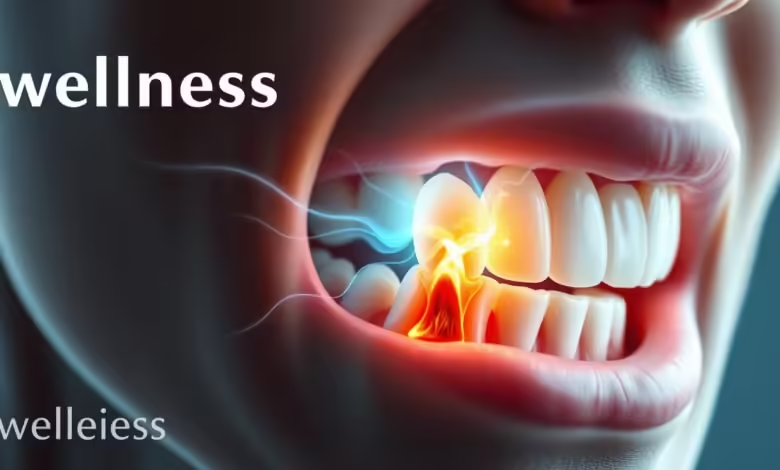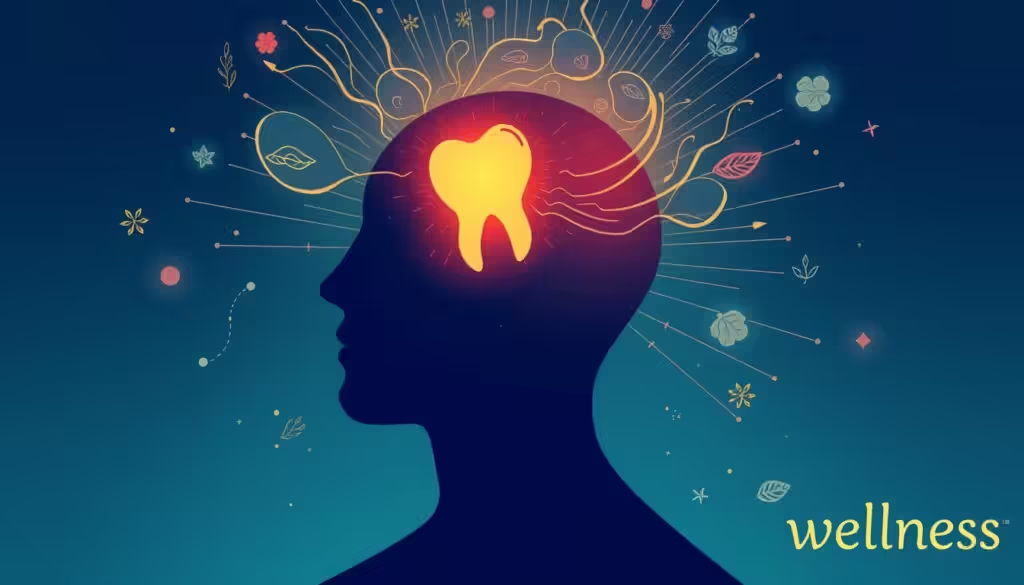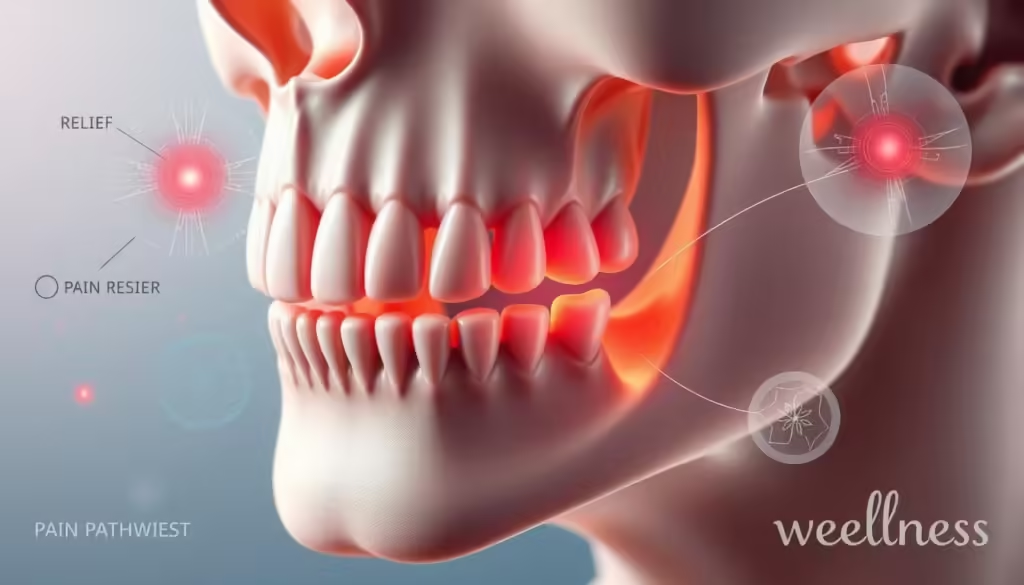does toothache cause headache

Toothaches and headaches are common health issues, but are they connected? It’s important to understand how dental pain and head pain might be linked. This article will look into the anatomy and causes of this connection. We want to draw attention to the frequently disregarded connection between headaches and toothaches.
A close-up of a human jaw and teeth, highlighting an inflamed molar with pulsating energy waves emanating from it, a subtle representation of stress and discomfort in the surrounding facial area, soft, cool color palette, anatomical style, focused on the interplay between dental pain and its effects on the head, evoking a sense of tension and unease, brand name “wellness zebra” subtly integrated into the visuals.
Key Takeaways
- Periodontal diseases have the potential to either cause or exacerbate a variety of headaches, including migraines.
- The connection between tooth pain and head pain is often due to referred pain, where pain from one area is perceived in another.
- Sinus infections and TMJ disorders are two conditions that can produce headaches and toothaches at the same time.
- Proper diagnosis and treatment of the underlying dental or medical condition is crucial for managing tooth pain and headaches.
- The greatest course of action for long-term relief is to address the underlying source of the issue rather than just treating its symptoms.
The Anatomy of Toothache and Headache
It’s important to know how tooth pain and headaches are connected. This connection is based on the anatomy and how pain can spread. Understanding this helps in treating these common health problems.
Understanding Dental Pain
Tooth pain comes from inflammation or irritation of the nerves in the tooth or nearby tissues. This can happen due to tooth decay, root canal infections, or jaw ache from a TMJ disorder. These problems can send nerve signals that cause pain in the affected area.
Headache Types and Triggers
There are several types of headaches, including cervicogenic headaches, tension-type headaches, and migraines. These headaches can be linked to dental pain. For example, a sinus infection can cause pain that feels like a headache.
| Headache Type | Potential Dental Triggers |
|---|---|
| Migraine | Tooth decay, TMJ disorder, sinus infection |
| Tension-type Headache | Teeth grinding, jaw clenching, TMJ disorder |
| Cervicogenic Headache | Neck tension, TMJ disorder, poor posture |
Knowing how tooth pain and headaches are connected helps doctors treat these conditions better. This leads to more effective treatment and relief for patients.
Does Toothache Cause Headache?
The link between toothache and headache is complex and debated by scientists. Some studies hint at a possible connection, but how dental pain affects head pain is still being researched.
One idea is that toothache and headache share nerves and pathways in the body. Dental pain might cause referred pain or make the trigeminal nerve more sensitive. This could lead to headaches or migraines. Even still, not much is known about this partnership.
Studies show that many people with tooth pain also get headaches. In fact, up to 40% of those with toothaches also have headaches. Fixing the dental issue can help ease the head pain too.
But, the link between toothache and headache isn’t always straightforward. Headache and dental discomfort can be brought on by tension, worry, and clenching of the jaw. Some headaches, like sinus or tension headaches, might be more related to toothache than others.
To sum up, there’s evidence that toothache and headache might be connected. But further study is required to properly comprehend this connection. We also need to find the best treatments for those with both dental and head pain.

A vivid illustration of a human silhouette with a glowing painful tooth and radiating lines representing a headache, in a soft color palette with abstract swirls of energy around the head, symbolizing discomfort, alongside subtle elements of wellness such as soothing nature motifs, all designed to evoke a sense of connection between toothache and headache, branded with the name “wellness“.
Potential Causes of Referred Pain
Toothaches and headaches can sometimes be connected due to the complex network of nerves in the head and face. Dental problems may be the cause of pain that is “referred” to” or experienced in other places, such as the forehead, temples, or even the back of the head. Understanding the potential causes of this referred pain is crucial for addressing the root of the problem.
TMJ Disorder and Jaw Pain
One common cause of referred pain is temporomandibular joint (TMJ) disorder. It often leads to jaw ache, facial discomfort, and even headache. A headache associated with TMJ disorders can be brought on by the sensitivity and tension in the TMJ, which can spread pain to the nearby muscles and nerves.
Sinus Infections and Tooth Pain
Another potential source of referred pain is sinus infection. Sinus-related issues can cause inflammation and pressure, which can be mistaken for tooth pain or dental pain. The shared nerve pathways between the sinuses and teeth can make it challenging to distinguish the true origin of the discomfort.
Identifying the underlying cause of referred pain is crucial for finding effective relief. Consulting a healthcare professional, such as a dentist or physician, can help determine the root of the problem. They can then develop a comprehensive treatment plan to address both the toothache and the associated headache.

A close-up of a human jaw showcasing the anatomy of the temporomandibular joint (TMJ), with highlighted areas of tension and discomfort, rendered in a semi-realistic style, featuring a soft color palette that conveys a sense of calmness, surrounded by abstract representations of pain pathways and relief, with subtle references to the theme of “wellness.”
| Condition | Symptoms | Potential Causes |
|---|---|---|
| TMJ Disorder | Jaw painHeadachesClicking or popping sounds in the jawLimited jaw movement | Teeth grinding or clenchingInjury to the jawStress and muscle tensionArthritis in the TMJ |
| Sinus Infection | Tooth painHeadachesFacial pressure or congestionNasal discharge | Viral or bacterial infectionAllergiesStructural issues in the sinusesWeakened immune system |
Managing Tooth Pain and Headaches
Dealing with tooth pain and headaches requires a detailed approach. Consult a dentist first to get the tooth examined and determine the problem. This could be a cavity, infection, or another dental problem. Getting the right treatment, like fillings or a root canal, can help stop the pain and headaches.
If you have ongoing headaches, think about a TMJ disorder. A TMJ specialist can look at your jaw and fix any issues. They might suggest mouth guards, physical therapy, or surgery for severe cases. Resolving TMJ issues can significantly lessen headaches and dental pain.
Along with seeing a doctor, there are things you can do at home to ease the pain. Over-the-counter pain relievers, warm or cold packs, and gentle jaw massage can help. Keeping your teeth clean, lowering stress, and avoiding headache triggers can also help manage these issues over time.
FAQ
Can a toothache cause a headache?
Yes, a toothache can sometimes trigger or contribute to headaches. Dental pain can cause referred pain that radiates to the head. This can lead to different types of headaches, including migraines, tension-type headaches, and cervicogenic headaches.
How are toothaches and headaches connected?
The connection between toothaches and headaches comes from the complex network of nerves in the head and neck. Dental pain can stimulate the trigeminal nerve. The face, jaw, and teeth convey impulses to the brain through this nerve.
This can make you feel pain in areas beyond the original source. This is known as referred pain and can cause headaches.
What types of headaches can be caused by a toothache?
Toothaches can potentially trigger or contribute to several types of headaches, including: – Migraines: Dental pain can be a trigger for migraine attacks, causing severe, throbbing head pain. – Tension-type headaches: Referred pain from a toothache can lead to muscle tension and pressure associated with tension-type headaches. – Cervicogenic headaches: Issues with the temporomandibular joint (TMJ) or jaw can cause pain that radiates to the neck and head, leading to cervicogenic headaches.
Can a sinus infection cause a toothache?
Yes, a sinus infection can sometimes cause or contribute to a toothache. Sinus-related issues, such as inflammation or infection, can put pressure on the maxillary sinuses. These are located above the upper molars.
This pressure can be perceived as pain in the teeth, leading to a toothache.
How can TMJ disorder lead to headaches?
Temporomandibular joint (TMJ) disorder, a condition that affects the jaw joint, can be a significant contributor to headaches. When the TMJ is not functioning properly, it can cause muscle tension, inflammation, and referred pain.
This pain can radiate to the head, triggering or exacerbating headaches.



